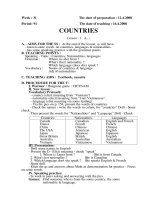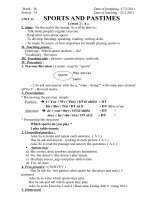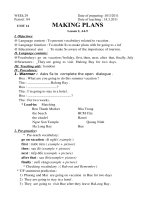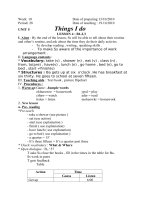giáo án anh văn 6 mới UNIT 7
Bạn đang xem bản rút gọn của tài liệu. Xem và tải ngay bản đầy đủ của tài liệu tại đây (227.27 KB, 12 trang )
UNIT 7 YOUR HOUSE
Lesson 1 A1-2 Page 72-73
Aims : Help Ss listening to a dialogue & reading a letter about a house to understand the details
Objectives : By the end of the lesson, Ss will be able to listen to the dialogue & reading a letter about a house to understand the details
Teaching aids : posters, cassette
Proceduces :
Time Teacher’s activities Student’s activities Rationale
5’
10’
REVISION
Jumbled words
1. igb = big
2. small = small
3. dyar = yard
4. lewl = well
5. wressflo = flowers
6. esetre= trees
PRE-LISTENING
- T/F prediction [Grid]
Answer key
Yes No
………big? v
………small? v
………a well? v
………a yard? v
……….flowers? v
……… trees? v
Use the grid to talk about Hoa’s house
- Example statements.
Hoa’s house is small. It is not big. There is a
yard. There are flowers. There isn’t awell.
There aren’t trees.
- Ask students write the correct
order.
- Feedback
- Write 5 or 6 to talk about the
main ideas of the text on BB
- Turn on the Cassette
- Write Ss’ prediction on the board
- Turn on the cassette one more
- Correct mistakes
- Guide to read the text
- One by one goes to the
board and write
these letters in the
correct order).
- Ss read again.
- Read these sentences
carefully.
- Listen to the tape
& tick Yes or No
- Give their prediction
- Listen again & check
their prediction
- Repeat in chorus
- Listen
• help students
remember
vocabulary
• help students
develop
listening skills
• help students be
able to analyze
LESSON PLAN – ENGLISH 6 Week: 14 Period: 41
15’
8’
2’
WHILE LISTENING
A1- IS YOUR HOUSE BIG ? p.72
PRE-READING
Pre-teach
- a garden: Vườn
- a vegetable: rau quả ( explanation)
- a photo : bức ảnh ( realia)
Slap the Board
T/F prediction
a) The house is in the country.
b) There’s a river near the house.
c) There are trees to the left of the house
d) There are two gardens.
WHILE – READING A2 p.73
Comprehension [Matching]
A2 p.73 a e
POST – READING / LISTENING
Transformation writing
(Describe Ss own house)
HOMEWORK
- Learn by heart Vocab.
- Do A 1, 2 ( P. 66- 67- workbook)
- Introduce the lesson & give some
new words
- Check vocabulary by slap the
board
- Guide how to play
- Write these sentences on BB
- Write their prediction on the
board
- Guide Ss to read the text & do
exercises
- Guide how to write from the main
text of the letter
* Keys.
a. T
b. F
c. F
d. T
- Give them some works to do at
home.
- Repeat
- Copy down
- Practise in groups
- Work in pairs to
predict the main ideas
of the text
- Read the text to check
their prediction
- Repeat in chorus
- Practise individually
- Change the underlined
information to describe
their own house & then
draw a picture of it as a
photo
- Listen and copy down
• help students
with
communication
skills
• help students
practice with a
new structure
sân
Vườ
n
rau
Cái giếng
Bức ảnh
Cái
hồ
UNIT 7 OUR HOUSE
Lesson 2 A3-5-6 Page 74-75
Aims : Help Ss practise facilities vocabulary with “Is there a…/ Are there any…?” and short answers to describe the town.
Objectives: By the end of this lesson, ss will be able to listen to a dialogue and read a letter about a house to understand the details and describe
about their house
Teaching aids : pictures, poster.
Proceduces :
Time Contents Teacher’s activities Student’s activities Rationale
4’
15’
15’
15’
WAWM - UP
How are you?
Where do you live?
Is your house old?
Is it beautiful ?
PRESENTATION
Pre-teach
- a bank: ngân hàng
- a clinic: phòng khám.
- a post office: bưu điện
- a super market: siêu thị.
- a shop: cửa hàng
- any: nào cả/ bất cứ
Presentation Dialogue A1 p.72
Model sentences
- Is there a yard? Yes, there is
well? No, there isn’t
- Are there any flowers?
Yes, there are.
No, there aren’t
PRACTICE
- Ask them some questions.
- Introduce the topic
- Elicit the new words
- Model
- Explain the meaning
- Write on the board.
- Check “ R.O.R”
- Present the dialogue
- Present the models on BB
- Explain how to use, form,…
- Give examples
- Model
- Show the pictures
- Listen and answer the
questions.
- Listen
- Repeat
- Copy down
- Listen
- Pick out the models from
the dialogue
- Practise in pairs
- Repeat
- Practise
- Look at the pictures
• help students
learn more new
words.
• help students
know how to use
new structure
• help students
practice with a
LESSON PLAN – ENGLISH 6 Week: 14 Period: 42
Picture Drill
A3 b) p.74 (8 pictures)
- Is there a bank near your house?
- No, there isn’t
- Is there a supermarketnear your school?
- Yes,there is .
- Are there any flowers near your house?
- Yes, there are.
FURTHER PRACTICE
A4/ p.74.Look at the pictures . Choose
one of the houses. Don’t your partner
which house. Ask questions to find which
house your partner chooses
Example:
S1: Are there any trees?
S2: Yes, there are.
S3: Are they behind the house?
S2: Yes, there are
S3: Is this the picture 2?
S2: Yes, It is.
HOMEWORK
- Learn by heart Vocab
- Do A1-6 (p66- 67- work book)
- Give example exchanges
- Guide how to practise
- Correct mistakes
Example Exchanges
S1 : Is there [a hotel] near your
house ?
S2 : Yes, there is. / No, there
isn’t.
S1 : Are there any [shops] near
your house?
S2 : Yes, there are. / No, there
aren’t.
- Ask Ss to look at the pictures
of A4 again
- Read a paragraph describing a
house. *.Consolidation
- Give them some works to do
at home.
- Practise in pairs
- Do the matching exercises
in writing
- Ss listen then predict which
picture is described
- Review “ Is there/ are there”
- Listen and take notes.
new structure
• help students
with
communication
skills
UNIT 7 OUR HOUSE
Lesson 3 B1 Page 76-77
Aims : Help Ss practise reading a text about Ba’s and Chi’s houses to understand the differences between town and country
Objectives : After the lesson, Ss will be able to read a text to understand the differences between town and country
Teaching aids : pictures
Proceduces:
Time Contents Teacher’s activities Student’s activities Rationale
5’
15’
REVISION
Hangman
(stores)
(clinic) (post / office)
(bank) (super market)
(rice / paddy) (flowers)
PRE-READING
Pre- teach
- noisy >< quiet : ồn ào >< yên tĩnh
- an apartment:căn hộ
- a zoo: vườn back thú
- paddy fields= rice paddy:
Rub out and Remember:
B1 picture p.76
Ba lives in an (1)………… in town. Near his
apartment, there is a supermarket, a post-
office,
(2)…………,a clinic, a market and a (3)
……… It is very(4)………here .
Chi lives in a (5)…………in the country .
There aren’t any stores here. There are not any
(6)…here.There are trees and (7)………, a
river , a lake and ( 8)……… It is very (9)
- Introduce the games
- Guide how to play
- Draw the pictures and the lines on
BB
- Elicit by a letter
- Present new words
- Model and write words on BB
- Give the meaning
- Check vocabulary by using ROR
- Give examples
- Divide into 2 groups
- Guess the words
from the lines
- Practise in group
- Listen
- Repeat
- Copy down
- Read words again
- Write words again
• help students
remember
vocabulary
• help students
learn more new
words.
• help students
contrast
between town
and country.
LESSON PLAN – ENGLISH 6 Week: 15 Period: 43
15’
8’
2’
……………in the country.
WHILE-READING
B1 p.76 (about Ba) – p.77 (about Chi)
Keys
1. apartment 4. noisy
2. a bank 5. house
3. zoo 6. stores
7. flowers. 8.quiet
Comprehension Qs [Matching] B1 a f
Model sentences.
Ba: Do you live in town?
Hoa: No. I live in the country.
Ba: Does Minh live in an apartment?
Hoa: No. He lives in a house.
* Form:
Do/Does + S + live+ ……………?
No, S + live(s)+………………
* Use:
Hỏi đoán xem 1 người nào đó sống ở đâu và
trả lời
POST-READING
Town/country Hospital/ factory
House/apartment Bank/post office
Lake/river Supermarket/ market
HOMEWORK:
- Learn by heart Vocab
- Write a paragraph describing place where
you live
- Do B1(66-67) workbook, Do B2 (77)
textbook.
- Read the text clearly
- Guide to answer the Qs
- Guide how to practise
Example Exchange:
S1: Do you live in town?
S2: No. I live in the country
- Give them some works to do.
- Guide them how to do exercises.
- Practise
- Repeat in chorus
- Answer the Qs in
writing
- Practise in groups
- Listen and take notes.
• helps students
recognize the
places in town
and country.
• help students
use the new
structure
• help students
practice with
the new
structures.
UNIT 7 YOUR HOUSE
Lesson 4 B
2-3
Page 77
Aims: Help Ss integrated skill practice to describe where they live
Objectives: By the end of the lesson, Ss will be able to use integrate skill practice to describe where they live
Teaching aids: Wordcards, pictures, cassette
Proceduces:
Time Contents Teacher’s activities Student’s activities Rationale
5’
10’
15’
10’
REVISION
Transformation writing B
2
p.77
Grid B
3
p.77 (listening)
PRESENTATION
Model sentences B
4
p.77
PRACTICE
Word cue Drill
1. Town / country
2. bank / post office
3. house / apartment
4. supermarket / market
5. hospital / factory
6. shops / paddy fields
7. zoo / museum
*Example exchanges
S
1
: Do you live (in town)?
S
2
: No, I live (in the country)
S
1
: Do you live (near a lake)?
S
2
: No, I live( near a river)
FURTHER PRACTICE
Find someone who
Find someone wholives names
-Write a short paragraph on BB.
- Turn on the cassette
- Present the models
- Show some word cues on BB
- Model (2 times)
-Give example exchanges on BB
-Guide to read
-Let Ss practise
- Read the paragraph
- Listen to the tape and
complete the table.
- Copy down.
- Read the word cues
clearly
- Repeat in chorus
- Copy down
- Practise based on the
example exchanges
- Practise in pairs
- Read the information
- Copy the chart on their
teacher.
- Listen.
• Help students
use the structure
• Help students
practice the
structures with
their friends.
LESSON PLAN – ENGLISH 6 Week: 15 Period: 44
5’
in town
in the country
near a lake
next to a market
opposite a paddy field
near a post office
Example exchange
S
1
: Do you live in town?
S
2
: No, I don’t/ yes, I do
S
1
: What’s your name?
S
2
: ………
S
1
: How do you spell it?
HOMEWORK
- Learn by heart the Vocab
- Do B1(66-67) workbook, Do B2 (77)
textbook
-Stick the poster on the board
-Guide how to do
-Model (2-3 Ss)
-Give example exchange on BB
- Give them some works to do.
- Guide them how to do exercises.
- Practise with the
teacher.
-Copy down
- Divide into groups
-Practise in groups
- Listen and take notes.
• Students can
communicate
with partner
using the
structures.
UNIT 7 YOUR HOUSE
Lesson 5 C
1-3
Page 78-80
Aims: Help Ss practise Simple present “ How” question and “by car/bike ” to talk about transportation
Objectives: By the end of the lesson, Ss will be able to use Simple present “How” question to talk about transportation.
Teaching aids: Pictures, poster
Proceduces:
Time Contents Teacher’s activities Student’s activities Rationale
5’
15’
REVISION
Guessing games: I’m going to the
Ex:
S
1
Are you going to the bank?
S
2
: No, I’m not.
S
3
: Are you going to the clinic?
S
2
: Yes, I am.
PRESENTATION
Pre-teach
- by bike: bằng xe đạp
- by bus: bằng xe buýt
- by motorbike: bằng xe máy
- by car: bằng xe hơi
- by train: bằng tàu thuỷ
- by plane: bằng máy bay
What and where
Presentation text
C
1-2
p.78-79
Model sentences
How do go to School :?
Does he travel to work?
I travel/go by bike
He travels/goes car
+ Form:
- Guide how to do
- Give the structure on BB
- Give example
- Introduce new words by using the
pictures (p.78) and situation
- Model and write
- Check vocabulary
- Present the text
- Use the text to give the model
sentences
- Explain how to form, use,
- Use the pictures C
2
p.78-79
- Choose a place in
town and complete the
sentence strip
- Practise in pairs
- Listen
- Guess and give words
in English.
- Repeat & copy down
- Practise in groups
- Repeat in chorus
- Copy down
- Practise in pairs
- Look at the pictures
to ask and answer
based on example
• Help students
remember the
lesson.
• Help students
use the new
words to ask
about
transportation
• Help them know
the structures :
“How do you go
to….?”
LESSON PLAN – ENGLISH 6 Week: 15 Period: 45
15’
8’
2’
- How + do/does + S + go/ travel to….?
→ S + go (es)/ travel(s) + by + phương
tiên
+ Use:
Hỏi và trả lời về phương tiện đi lại.
PRACTICE
Substitution Drill:C
2
p.18-79
S
1: H
ow does (Lien) go to school ?
S
2
: She goes by (bike)
S
1
: How does (Mr Hai) travel to work?
S
2
: He travels by (train)
PRODUCTION
Noughts and Crosses
Mrs. Lien Mrs. Lan Mr Hai
Dung Thu Tuan
Mr Ba Mr Kim Miss
Hoa
Example Exchange
S1: How does Mrs. Lien go to work?
S2: She goes by bike
HOMEWORK
- Learn by hear Vocab/ Model
sentences (form)
- Write sentences telling about your
family’s member transportation
- Do C1, C 2 (p.68) – workbook
- Give example exchanges on BB.
- Model
- Draw the chart on BB and explain
how to play games
- Practise in pairs
- Copy down
- Divide into 2 groups
- Play games
• Help them
practice with
their friends
using the
structures.
• Help them
communicate
with their
friends.
UNIT 7 YOUR HOUSE
Lesson 6 C
4-5
Page 80
Aims: Help Ss practise reading a text about Hoang’s daily routine for further practice in simple present habitual action
Objectives: After the lesson, Ss will be able to read a text and use simple present habitual action
Teaching aids: poster
Proceduces:
Time Contents Teacher’s activities Student’s activities Rationale
5’
10’
15’
REVISION: C
3
p.80
Find some who
Find some who Name
get up at 5.30
get up at 6
walk to School :
goes to School : by bus
goes to School : by bike
Ex:S
1:
Do you get up at 5.30?
S
2
: Yes, I do./ No, I don’t
PRE-READING
(open) Prediction
What time?
-He gets up
-He leaves the house
-School : starts
-School : ends
-He has lunch
WHILE READING C
4
p.80
Comprehension Questions C4 p.80
a. at half past five.
b. At half past six.
- Use the exercises C4 p.80 to review
- Let Ss play “find someone who”
- Stick the poster on BB
- Give examples
- Model.
- Supply the chart on BB.
- Guide how to do
- Write the times on BB
- Guide to read the text.
- Correct mistake
- Give the topic & write the things on
BB.
- Look at C
4
p.80 again
- Divide into 2 groups
- Play games
- Copy down.
- Practise in pairs-
groups
- Copy down
- Guess what time
Hoang does the
following things.
- Give the times
- Repeat in chorus
- Check their
predictions
- Ask and answer in
• Help them
remember the
structure and
practice in
groups.
• Help students
understand the
text and answer
LESSON PLAN – ENGLISH 6 Week: 16 Period: 46
8’
2’
c. No, he doesn’t.
d. Yes, he does.
e. Classes start at seven.
f. They end at half past eleven.
POST-READING
Survey
Name Activities What time
Get up
Go to School
Classes start
Classes end
Go home
Have lunch
HOMEWORK
- Revise Vocab
- Write a paragraph about your daily
routine
- Do C4(71)
- Give the correct answer.
- Guide how to do
- Correct mistakes
- Give them some works to do.
pairs.
- Some of them write on
the board.
- Copy down
- Divide into 2 groups
- Practise in groups
- Listen and take notes.
the questions.
• Help them use
the words and
practice in
groups.
TỔ TRƯỞNG CHUYÊN MÔN









